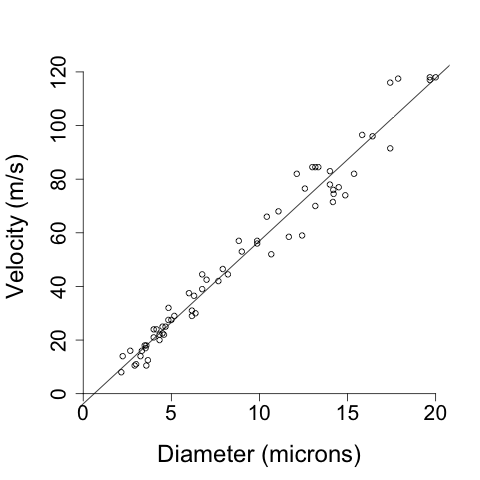# Code initially written by Ryan Sieberg.
# First set up a PNG graphics device in which we will print the image.
png("../figures/hurshR.png")
# Read data from CSV.
hursh <- read.csv("../data/hursh.csv")
# hursh contains two named columns, 'diameter' and 'velocity'.
# The 'par' commands change graphical parameters. cex stands for
# "character expansion" and determines the size of text, in this
# case, cex.lab changes the size of the label.
par(cex.lab=2)
# cex.axis changes the size of the axis font.
par(cex.axis=1.75)
# mar changes the margins of the graph area.
par(mar=(c(5,4.7,4,2)+.1))
# Create a linear model for the hursh data.
lmhursh<-lm(hursh$velocity ~ hursh$diameter)
# Plot the data.
plot(hursh$diameter,
hursh$velocity,
main="",
axes=FALSE,
xlab="Diameter (microns)",
ylab=" Velocity (m/s)",
xlim=c(0,20),
ylim=c(0,120))
axis(1,pos=0)
axis(2,pos=0)
# Add a line. The linear model object "lmhursh" contains a list
# called "coef", which contains the coefficients of the model. The
# first entry is the intercept, and the second is the coefficient for
# velocity. They are stored as strings, so we convert them to
# numerics before using them in abline.
intercept <- as.numeric(lmhursh$coef[1])
slope <- as.numeric(lmhursh$coef[2])
abline(intercept, slope, untf = "FALSE")
# With our figue complete, close the connection to the PNG.
dev.off()

